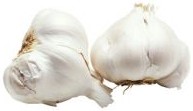
 |
AlliinThe chemical in garlicBy: Eric Coleman, 3rd yr Chemist,
|

The main component in raw garlic is alliin (a full list of structures is here). But as soon as you crush or cut a clove of garlic, the cell walls are split so that an enzyme called alliinase is released, which converts alliin into allicin. See reaction for more details.
Allicin is the chemical which gives garlic its odor. It is a strong oxidant, which means that it creates free radicals, which in excess, can be dangerous. Allicin can cause stomach irritation and, in rare cases, hemolytic anemia, destruction of red blood cells.
If if placed directly on the skin, allicin can cause blistering. During cooking, allicin produces ajoene, DADS (diallyl disulfide) and other compounds that may help keep blood from clotting.
During aging, alliin and allicin are converted to water-soluble compounds such as S-allyl cysteine and S-allyl mercaptocystine, which have little odor, are chemically stable and survive cooking. These are among the ingredients in "aged garlic extract" supplements and may help combat cancer and protect against heart disease.
Garlic also contains oil-soluble compounds like DAS (diallyl sulfide) and DADS which are thought to have beneficial effects on blood pressure, lipids and clotting and may help prevent cancer. This is a current area of research.